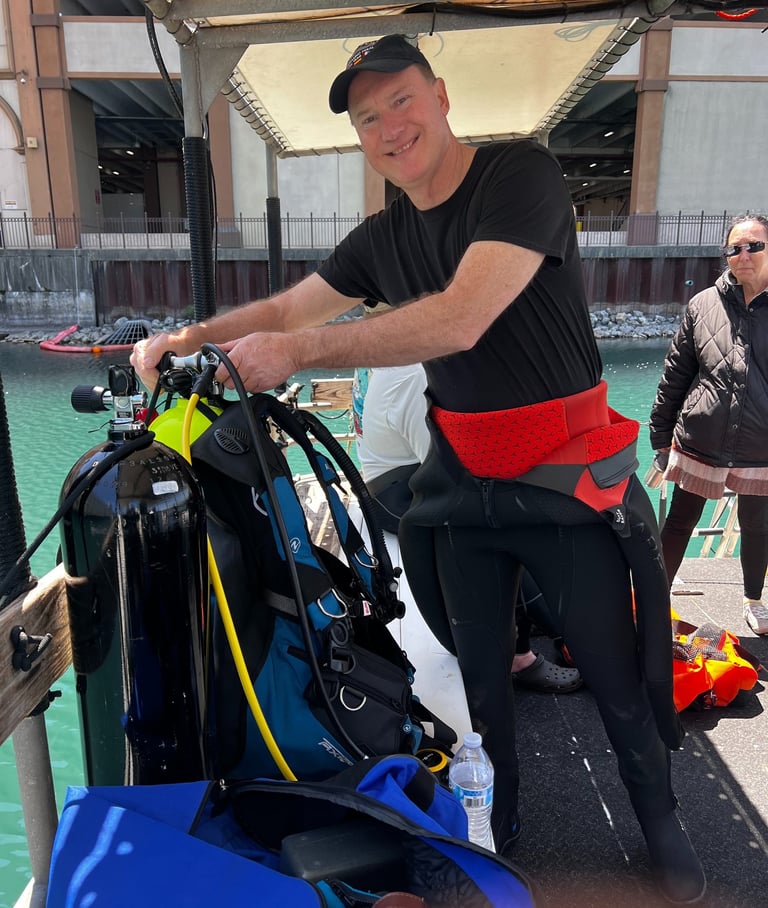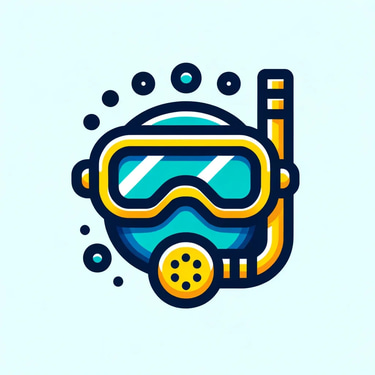Clearing Your Ears Early and Often: A Hard Lesson From 35 Feet Down
IF YOU ARE NEW TO DIVING...START YOUR JOURNEY HERE


Scuba diving offers some of the most incredible experiences on Earth. But it also demands a lot of respect for the underwater environment — and for your own body. One of the most critical things every diver must master is equalizing the ears early, often, and gently. This is something I thought I understood well after years of diving, but a recent experience reminded me just how important this simple habit is.
In this blog, I’ll share the story of what happened to me on a recent dive, the consequences of diving while congested, and actionable advice every diver (especially beginners) should take seriously when it comes to ear safety and equalization.
⚠️ My Experience: Equalizing Trouble at 35 Feet
On my last dive, I was dealing with some mild sinus congestion. I knew I probably shouldn’t have gone in, but like many divers, I brushed it off. I felt okay on the surface, and I figured I'd be fine once I got underwater.
About 10 minutes into the dive, I began my descent to around 35 feet. That’s when I hit a wall. My ears wouldn’t clear, and I felt increasing pressure. I pinched my nose and attempted a gentle Valsalva maneuver — the usual method of blowing gently against a closed nose and mouth to equalize. It didn’t work.
I paused, ascended slightly, and tried again. Still nothing. Finally, out of frustration, I gave a stronger blow through my nose while pinching it. I felt a pop — and a rush of relief as the pressure released.
The rest of the dive went smoothly, or so I thought. But later that day, I noticed a strange sensation in my ear. It felt full, and I began hearing a persistent noise, like radio static or a faint buzzing. I assumed it would pass. Instead, it got worse.
I went to a doctor and was diagnosed with an inner ear infection — likely triggered by forcing an equalization while congested. My eustachian tubes were inflamed, and the fluid buildup had created a breeding ground for bacteria.
To this day, I still occasionally hear that static when things are quiet.
🔊 Why Equalizing Is So Important
When you descend in the water, pressure increases rapidly. Your body adjusts naturally, but the air spaces in your head — particularly in your middle ear — require help balancing the pressure. That’s what equalizing does: it opens the Eustachian tubes, allowing air in to match the water pressure outside.
If you don’t equalize properly and frequently:
Pressure builds in the ear
The eardrum stretches painfully
Eventually, barotrauma or a ruptured eardrum can occur
Infections can follow if fluid is forced into places it shouldn’t be — exactly what happened to me.
❌ Never Dive With Congestion
This cannot be emphasized enough: if you are congested, do not dive. Even if you feel "okay" above water, congestion blocks the Eustachian tubes, making it difficult or impossible to equalize. And worse, you might not realize you have a blockage until you're already underwater and under pressure.
I knew this. But I let my desire to dive override my better judgment, and I paid the price.
Diving with sinus issues puts you at risk for:
Ear barotrauma
Inner ear infections
Reverse blocks on ascent
Vertigo and balance issues
Always err on the side of caution. If you’re not 100%, don’t go down.
⏳ Equalize Early and Often
One of the biggest mistakes I made on that dive was waiting until I felt pressure before equalizing. That’s too late.
Here’s what every diver should do:
Start equalizing before you descend
Equalize every 1–2 feet as you go down
Don’t wait for pain — make it a rhythm
If you struggle, ascend slightly and try again
Make equalization a natural, habitual part of your descent. It should be almost automatic, like breathing.
🤎 Techniques That Work
Everyone's anatomy is a little different, so it’s smart to try several equalizing techniques to see what works best:
1. Valsalva Maneuver: Pinch your nose, close your mouth, and blow gently. Never force it.
2. Toynbee Maneuver: Pinch your nose and swallow. Great for gentle, passive equalization.
3. Frenzel Maneuver: More advanced, using throat and tongue muscles to push air toward the ears.
4. Jaw Wiggling/Swallowing: For many divers, this is enough to keep things balanced.
Practice these on land and before every dive. Flexibility and familiarity help your Eustachian tubes respond better underwater.
🚤 Gear and Tools That Help
You can also support healthy ears with a few products:
Reef-friendly nasal spray or saline mist (non-medicated)
Earol Swim Natural Spray — helps lubricate the ear canal
Custom dive masks with ear covers (like the ProEar mask)
Only use decongestants or medicated sprays under a doctor’s guidance, and never as a substitute for proper dive judgment.
📆 Post-Dive Awareness
If you experience symptoms like:
Fullness in your ear
Persistent noise (buzzing, static)
Pain after the dive
Vertigo or nausea
Seek medical attention. Don’t assume it will go away. Ear problems can worsen without treatment.
🚀 Final Thoughts: Don’t Learn the Hard Way
My experience taught me a valuable lesson: don’t dive when congested, and don’t force equalizations. I knew better, but I let excitement override caution.
Now, I’m sharing this story to help others avoid the same mistake. Equalizing early and often is one of the most basic, most important habits you can build as a diver. Listen to your body, dive conservatively, and take care of your ears.
There’s a whole ocean out there to explore. Don’t let one bad decision ruin your ability to enjoy it.
For more tips on dive safety, beginner gear guides, and stories from the deep, check out ScubaBlast.com.
Stay safe. Dive smart.
#ScubaBlast #DiveSmart #EveryDiveCounts #EqualizeEarly #EarHealth #ScubaSafety
